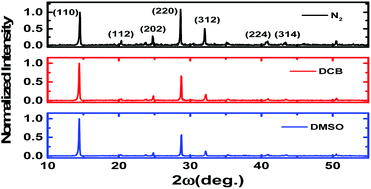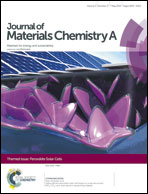Organic solvent vapor sensitive methylammonium lead trihalide film formation for efficient hybrid perovskite solar cells
Abstract
The anisotropic electronic properties of the perovskite crystals originating from their non-cubic crystal structures can potentially give rise to the grain orientation correlated photovoltaic device performance. Here we report that an organic solvent vapor atmosphere introduced during the spin-coating and formation of perovskite films changes the orientation and size of perovskite grains. It was found that slightly larger but much more oriented methylammonium lead trihalide (CH3NH3PbI3) grains could be obtained under 1,2-dichlorobenzene (DCB) and dimethyl sulfoxide (DMSO) vapor atmospheres. The devices with more oriented grains outperformed regular devices with more random grains by a 50 mV larger open circuit voltage as well as a slightly increased fill factor. The device efficiency enhancement can be attributed to the longer charge recombination lifetime resulting from the reduced trap density and oriented grains. This result is important in providing guidelines for comparing the results from various groups because organic solvent vapors are generally present in a sealed glovebox for perovskite solar cell fabrication.

- This article is part of the themed collection: Perovskite Solar Cells

 Please wait while we load your content...
Please wait while we load your content...